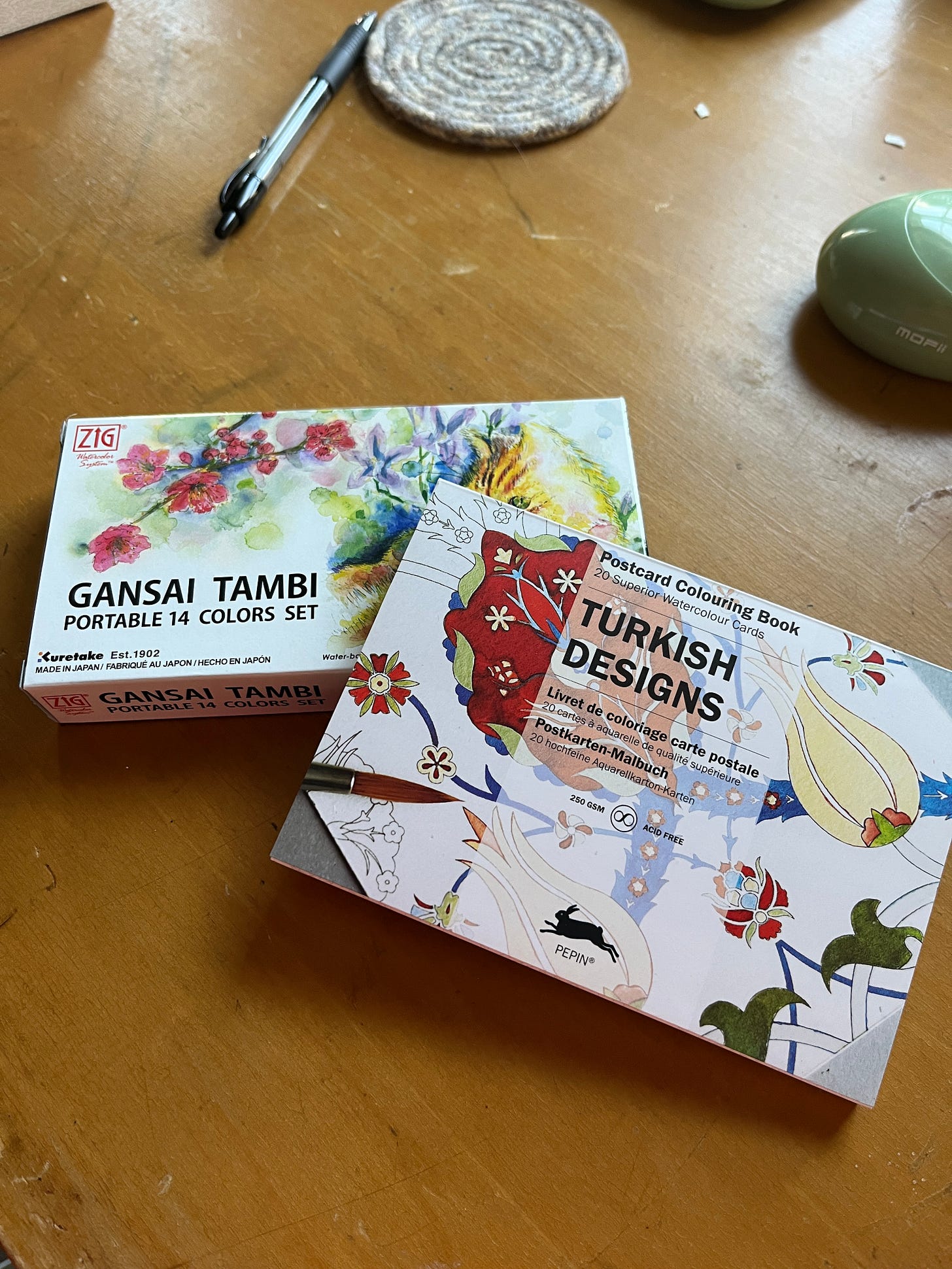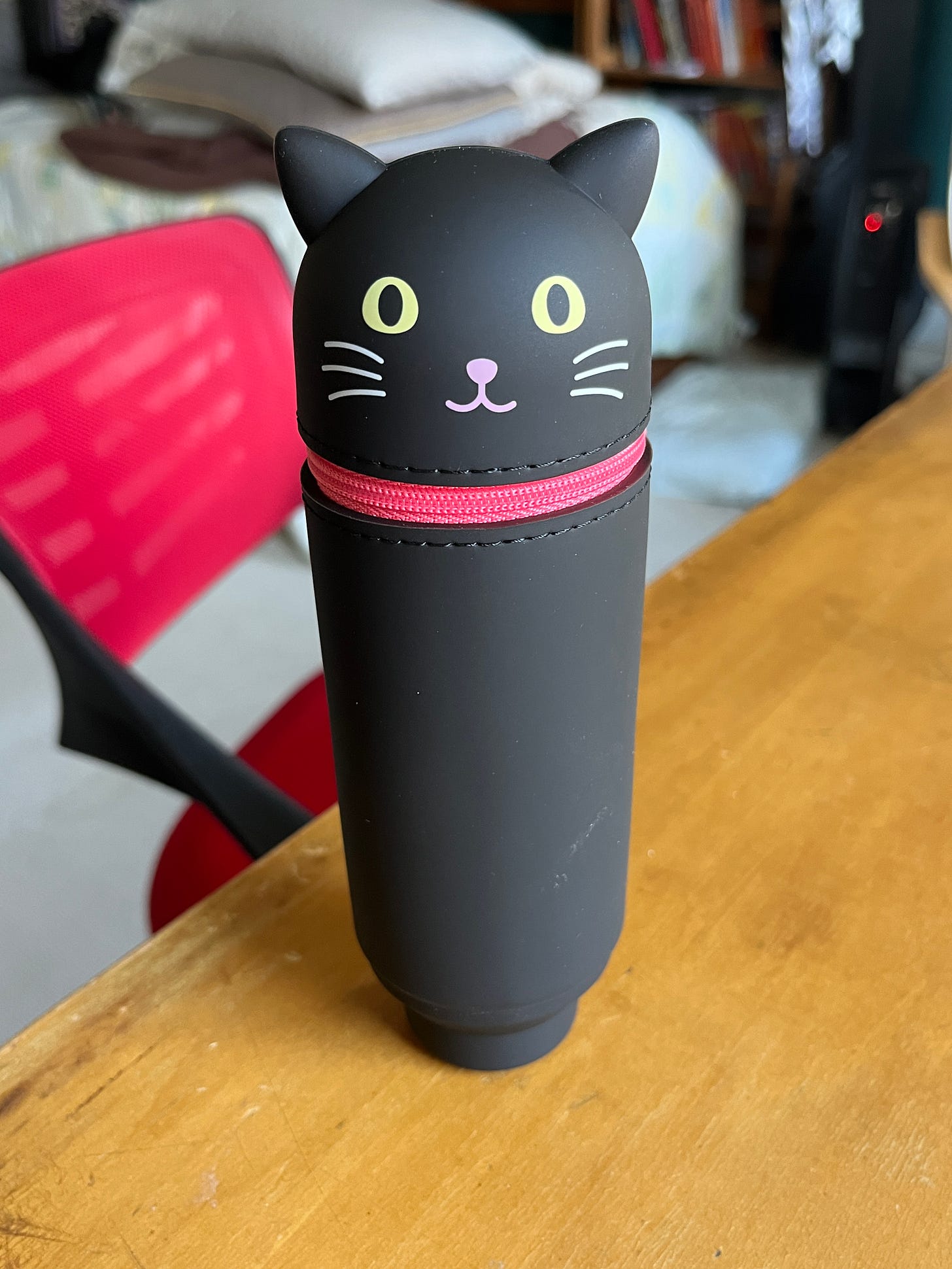The Ziploc bag option
Imagine you found this newsletter in a Ziploc bag along the shore or in the ditch. Would that be better or worse?
If you’ve been following along, you know that last week I enjoyed a totally purposeless vacation. This purposeless vacation included a fully ecstatic experience with biscuits and whipped cane syrup butter, so that was a bonus. Also a visit to a local art supply store, where I bought this adorable pencil holder and a tiny, portable water color kit. I haven’t done water colors since I was a small child and did those coloring books where the water itself turned the page certain colors. Remember those? That’s about the extent of my water color skills, but I bought the kit all the same, along with some postcards with Turkish designs to be filled in. Water color for beginners.
I also went to a very strange bookstore. Too few books in too large a space. Weirdly curated. Have you ever been in a bookstore, full of new books, and you could not find one single book you wanted to read, let alone buy? Perhaps because you’ve read most of what they have. Or because so much of what they have is uninteresting to you. Or maybe because all of the ‘it’ books on display anymore are just so fucking boring, as in, they’re all the exact same fucking book. Domestic noir. Dark academia. Dystopia, dystopia, dystopia. Historical fiction about a famous white, European or American woman, who is always in a beautiful dress facing away from our gaze on the cover. I feel a little sick just writing that.1
That’s how I felt in that bookstore. And I didn’t have to buy a book, but I like to buy books in indie bookstores when I travel. In fact, that’s probably where most of my book-buying happens. On the road.
A couple of days before, I’d bought two books at the friends of the library store in their big downtown branch. One of the books turned out to be something I’d read before, though I didn’t realize that until over a hundred pages in. The second was The Cry of the Dove, by Fadia Faquir, which was gorgeous and cost exactly $1. The Cry of the Dove was not dark academia or dystopia. It was also not a ‘social issues’ book. I mean, it was. It’s about a Bedouin woman who has to flee home to escape an honor killing. But this fact lurks at the margins of the story while she negotiates life in England. While she longs for companionship and love and a way to fit in. While she eavesdrops on dudes selling falafel and visits the local.
The book didn’t fit a trope, is what I’m saying. It defied the expectation I had when I picked it up. That made me so happy. I want my expectations blown out of the water by books. I miss that.
The book I did end up buying at the strange bookstore was Ruth Ozeki’s A Tale for the Time Being. This book also fits no tropes. I can sum up the “plot” for you fairly simply. That won’t tell you what the book is about because what it is about is infinite. The book is so big it contains more than its pages and its words. It spills and infiltrates.
I don’t know. I always have a special place in my heart for books I read on vacation. There’s something about the attention you’re able to give to those words. But also, A Tale for the Time Being feels like a book from a previous era. A time when not every book needed a gimmick. Or a following. Or, you know, whatever.
Here’s the basic idea of the book—a young Japanese woman writes a diary—a book—that ends up washing ashore in Canada. It’s found by Ruth, a novelist who may or may not be Ruth Ozeki herself. Ruth reads the diary and begins to try to discover whether the girl in the diary really exists. The two of them—the girl and Ruth—become entangled. Quantum mechanic hijinks ensue.
Obviously, the book gave me a lot to think about—the nature of time and reality. One of the central themes is that we are all time-beings. We live in time. We are made of time. We are connected by time. What does it mean to be a time-being? See how the book is bigger than its story? Bigger than its pages?
The thing I really can’t let go of, though, is all the questions about readership and audience that the book raises. The girl’s diary is necessarily set in the past, but Ruth is reading it in the present. The girl in the diary speaks to Ruth, her reader. She imagines her reader as a person and as her friend. And Ruth, of course, worries about the girl, even though whatever is happening in the girl’s life has already happened. All of this from a diary sealed in multiple Ziploc bags and covered in barnacles and sent, somehow, across the ocean. How’s that for a method of getting your words out into the world? How’s that for a way of finding your audience? A message in a bottle. A message in a Ziploc bag.
This month is coming up on the anniversary of self-publishing my young adult novel, FAIR GAME. If you’ve been around this long, maybe you remember all that anxiety and fanfare. Maybe not. It’s fine either way.

With it being the anniversary and all, I’ve been contemplating a series of posts about what I learned from the self-publishing experience. Spoiler: it would all boil down to go slower, do more research, and do not expect to make any money. In fact, expect to come out in the red. You can see how writing that is not the most exciting prospect.
On the other hand, maybe many people would read such posts which would drive growth to my newsletter and my subscribers and…and…and…Yeah, I don’t know. What’s the end game there? When I have a certain number of subscribers, what exactly will happen? I, too, will get to publish a tropified book, perhaps dystopian with a white woman with her back turned to us on the cover? Is that the prize at the end?
What I’m saying is, I’m feeling fairly disaffected with the whole thing. Substack. Publishing. The little trickle of rejections from literary journals and agents and editors and, I don’t know, random people on the street. It’s not hopelessness, I don’t think. It’s weariness. Pointlessness. Ennui. Wouldn’t it maybe make more sense to write a book and seal it in a Ziploc bag and send it down the river? Isn’t it about the same, in the end? In fact, isn’t the Ziploc option a little more exciting? A little more magical? A little more entangled on a quantum level?
Or maybe not Ziploc. Maybe postcards with strange koans slipped in between merchandise in random stores. Curled slips of paper attached to the legs of the tiny flock of pigeons that whirl around and around downtown Madison. Chalk haikus scrawled along the sidewalk and in one of our brand-new parking lots. Zines left on the table in the coffee shop. Year-long recitations of short story cycles while wearing elaborate costumes. A novel performed as a ballad at open mic nights. An essay as a four-course dinner or a bespoke cocktail.
I don’t know. It all makes as much sense as any of the rest of it, doesn’t it?
Let me say that this is also what makes me appreciate a beautifully curated bookstore, like Tomorrow Bookstore in Indianapolis, where I want to buy ALL THE BOOKS.



I’m going to check out the tiny legs of Mourning Doves, look for postcards hidden on Aldi’s shelves. Even take a moment to read the chalk scribbling on the side walks.
Robyn, you give such an honest, fresh look at your writing & publishing experiences.
Plus, I am fascinated now about the diary in a ziploc bag!!! Sounds like a must read for me.
I've also had coloring post cards that I got on a trip! But I never bought water colors on a trip, yet I do have a water color set I bought recently on Amazon... I get what you mean about those types of bookstores and everything anymore is dystopian! Omg- yes. These romance stories too but there are quite a few gems out there-- you just have to know where to look, anymore. 'The Island of Sea Women'- Lisa Ko is historical fiction but in a totally different setting than you're referring to here, but I get it. Anyways, hope you're good. First real day I get to read my newsletters this week and I'm catching up on yours now! Xoxo. 💕